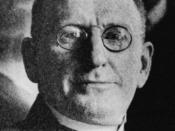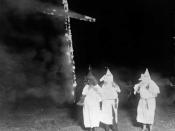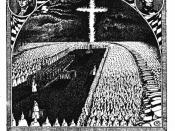The Ku Klux Klan of the 1920s provided what was perhaps one of the most spectacular examples of patriotism, secrecy and malevolence ever witnessed, and as with all sensational organisations , has been subject to a great deal of speculation concerning it's origins and success. The second Ku Klux Klan, which was modelled on the Reconstruction-era order , has myriad causes attributable to its rise. Essentially it was the perfect formula of financial opportunism and the chameleonic nature of the Klan , that successfully manipulated existing grievances into a barrage of support for the hooded order. Factors such as popular cultural revisionism , World War One and the ensuing changes to the traditional American way of life as well as the hatred of foreigners were contributing factors to the Klan's re-birth. In addition, the agricultural depression as well as the elaborate pageantry and appeal of the Ku Klux Klan all contributed to its re-invigoration and were capitalised upon by the superior salesmanship of Edward Y.
Clarke and Mrs. Elizabeth Tyler . This partnership was employed due to the dwindling capacities of the Klan's original founder, "Colonel" Simmons, and his young organisation would certainly have dwindled to an untimely demise if it had not been for his employees' significant influence.
Perhaps the earliest contribution to the re-emergence of the Ku Klux Klan was the process of academic and popular cultural revisionism of the Reconstruction-era Klan, which occurred at the outset of the twentieth century . Note-worthy scholars such as John W. Burgess, William A. Dunning and John Ford Rhodes revised the history of radical rule in the South; their interpretation would have one believe that hordes of savage Negroes ran rampant throughout the South, crushing the rights and freedom of native whites . In hindsight, white opposition to the vice...



The kkk
the kkk are evil people and they should all die and burn in hell!!!!
1 out of 3 people found this comment useful.